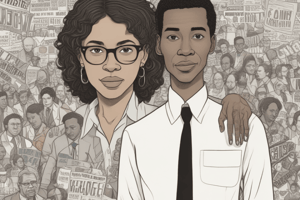Podcast
Questions and Answers
What does surface level diversity primarily consist of?
What does surface level diversity primarily consist of?
- Differences in easily perceived characteristics (correct)
- Differences in deep-rooted values
- Differences in experience and skill sets
- Differences in personality and work preferences
Which of the following best describes deep level diversity?
Which of the following best describes deep level diversity?
- Differences that focus solely on demographic characteristics
- Differences in underlying values and personality traits (correct)
- Differences that are easily captured by personnel records
- Differences that are noticeable at first glance
What is a common consequence of stereotyping?
What is a common consequence of stereotyping?
- Judgments made about individuals based on group perceptions (correct)
- Increased collaboration between individuals
- Enhanced understanding of diverse perspectives
- Improved social networks among employees
Which type of discrimination is characterized by actions that deny equal opportunity?
Which type of discrimination is characterized by actions that deny equal opportunity?
What is defined as unwanted sexual advances creating a hostile work environment?
What is defined as unwanted sexual advances creating a hostile work environment?
How does age correlate with productivity and turnover rates in the workplace?
How does age correlate with productivity and turnover rates in the workplace?
Which of the following does NOT represent a type of discrimination?
Which of the following does NOT represent a type of discrimination?
What is the term for the fear of being judged based on a stereotype?
What is the term for the fear of being judged based on a stereotype?
Which ability involves exerting force against external objects?
Which ability involves exerting force against external objects?
What is the definition of spatial visualization?
What is the definition of spatial visualization?
Which of the following abilities relates to moving the trunk and back muscles as far as possible?
Which of the following abilities relates to moving the trunk and back muscles as far as possible?
Which basic ability allows a person to maintain equilibrium despite outside forces?
Which basic ability allows a person to maintain equilibrium despite outside forces?
What is the main focus of diversity management?
What is the main focus of diversity management?
Which group is more likely to face disadvantages in employment decisions compared to others?
Which group is more likely to face disadvantages in employment decisions compared to others?
What is the relationship between tenure and job performance?
What is the relationship between tenure and job performance?
Which of the following statements about federal law on discrimination based on sexual orientation is true?
Which of the following statements about federal law on discrimination based on sexual orientation is true?
Which of the following is classified as a disability according to the US Equal Employment Opportunity Commission?
Which of the following is classified as a disability according to the US Equal Employment Opportunity Commission?
What type of reasoning does inductive reasoning involve?
What type of reasoning does inductive reasoning involve?
Which dimension of intellectual ability refers to understanding written and spoken information?
Which dimension of intellectual ability refers to understanding written and spoken information?
What is meant by a positive diversity climate in an organization?
What is meant by a positive diversity climate in an organization?
Which of the following is NOT considered a hidden disability?
Which of the following is NOT considered a hidden disability?
Which ability encompasses the capacity to sustain maximum effort over an extended period?
Which ability encompasses the capacity to sustain maximum effort over an extended period?
Which ability allows a person to make quick, repeated flexing movements?
Which ability allows a person to make quick, repeated flexing movements?
Which term describes the process by which managers become more aware of and sensitive to the differences and needs of others?
Which term describes the process by which managers become more aware of and sensitive to the differences and needs of others?
What is defined as the ability to exert muscular strength using the torso muscles?
What is defined as the ability to exert muscular strength using the torso muscles?
Which ability pertains to the capacity to exert maximum energy in a single or series of explosive actions?
Which ability pertains to the capacity to exert maximum energy in a single or series of explosive actions?
What primarily differentiates deep level diversity from surface level diversity?
What primarily differentiates deep level diversity from surface level diversity?
Which of the following statements accurately reflects a consequence of discrimination in organizations?
Which of the following statements accurately reflects a consequence of discrimination in organizations?
What does stereotypical threat primarily concern?
What does stereotypical threat primarily concern?
In the context of diversity, what do biographical characteristics represent?
In the context of diversity, what do biographical characteristics represent?
Which action exemplifies mockery and insults in a workplace setting?
Which action exemplifies mockery and insults in a workplace setting?
What factor does NOT typically contribute to lower productivity in older workers?
What factor does NOT typically contribute to lower productivity in older workers?
Which type of discriminatory action is characterized by exclusion from job opportunities?
Which type of discriminatory action is characterized by exclusion from job opportunities?
What is a common issue faced by Muslim employees in the workplace?
What is a common issue faced by Muslim employees in the workplace?
What statement best describes the relationship between tenure and job performance?
What statement best describes the relationship between tenure and job performance?
Which dimension of intellectual ability is associated with solving problems through logical sequences?
Which dimension of intellectual ability is associated with solving problems through logical sequences?
Which of the following best describes the implications of the Americans with Disabilities Act related to hidden disabilities?
Which of the following best describes the implications of the Americans with Disabilities Act related to hidden disabilities?
How do performance evaluations of workers with disabilities typically compare to those without disabilities?
How do performance evaluations of workers with disabilities typically compare to those without disabilities?
What is a primary reason for the disparity in employment decisions between African Americans and whites?
What is a primary reason for the disparity in employment decisions between African Americans and whites?
Which of the following describes the legal standing regarding discrimination based on sexual orientation?
Which of the following describes the legal standing regarding discrimination based on sexual orientation?
In the context of a positive diversity climate, which of the following is emphasized?
In the context of a positive diversity climate, which of the following is emphasized?
Which of the following dimensions of intellectual ability refers to qualities associated with rapid and accurate arithmetic?
Which of the following dimensions of intellectual ability refers to qualities associated with rapid and accurate arithmetic?
Which category of ability is predominantly linked to performing physical tasks and exerting force?
Which category of ability is predominantly linked to performing physical tasks and exerting force?
Flashcards are hidden until you start studying
Study Notes
Diversity in Organizations
-
Surface Level Diversity: Involves easily perceived characteristics like gender, race, ethnicity, age, or disability. This type does not necessarily indicate how individuals think or feel but may trigger stereotypes.
-
Deep Level Diversity: Relates to differences in personality, values, and work preferences. These become more significant as individuals build relationships over time.
-
Connection between Surface and Deep Level Diversity: Individuals may dislike those they do not know, leading to a cycle of hatred and ignorance.
-
Stereotyping: Involves making judgments about someone based on assumptions about their demographic group.
-
Discrimination: Refers to the unequal treatment of individuals, often based on stereotypes associated with their demographic group.
-
Stereotypical Threat: Refers to the anxiety of being judged or treated negatively due to a stereotype.
Types of Discrimination
-
Discriminatory Policies or Practices: Actions that unfairly deny equal opportunities or rewards based on demographic characteristics.
-
Sexual Harassment: Unwanted sexual advances or conduct that creates a hostile work environment.
-
Intimidation: Involves overt threats or bullying targeted at specific employee groups.
-
Mockery and Insults: Negative humor that attacks stereotypes, which may escalate into more severe forms of discrimination.
-
Exclusion: Involves omitting certain individuals from job opportunities, social events, or discussions.
-
Incivility: Disrespectful behavior, such as aggression or interruptions, affecting workplace dynamics.
Biographical Characteristics
-
Biographical Characteristics: Objective traits like age, sex, race, and tenure that reflect surface level diversity.
-
Age: Older workers often have lower turnover and absenteeism rates, and age does not correlate with decreased productivity.
-
Sex: Studies show no significant differences in analytical skills or problem-solving abilities by gender. However, women face wage disparities and fewer professional opportunities.
-
Race and Ethnicity: Legal protections exist against discrimination, yet biases persist in evaluations and opportunities, particularly for African Americans.
-
Tenure: Generally predicts employee productivity positively correlated with job performance.
-
Religion: Discrimination based on religion remains prevalent, especially affecting certain groups like Muslims.
-
Sexual Orientation and Gender Identity: Federal protection against discrimination is lacking, though many states and companies have policies covering these aspects.
Cultural Identity and Disabilities
-
Cultural Identity: Importance of respecting and accommodating individual cultural identities within the organization.
-
Disabilities: Defined by substantial impairments that limit major life activities. Organizations must adapt to a wide range of physical and mental impairments.
-
Workers with Disabilities: Often perform well but may have lower expectations.
-
Hidden Disabilities: Include sensory disabilities, chronic illnesses, cognitive impairments, and psychological challenges that organizations must accommodate.
Positive Diversity Climate
- Positive Diversity Climate: An organizational environment that embraces inclusiveness, acceptance, and respect for diversity.
Abilities in the Workplace
-
Ability: Refers to an individual's potential to execute job-related tasks.
-
Intellectual Abilities: Involve mental tasks such as thinking, reasoning, and problem-solving, encompassing general mental ability.
-
Dimensions of Intellectual Ability:
- Number aptitude
- Verbal comprehension
- Perceptual speed
- Inductive reasoning
- Deductive reasoning
- Spatial visualization
- Memory
-
Physical Ability: Refers to stamina, dexterity, strength, and related characteristics needed for physical tasks.
-
Basic Physical Abilities:
- Dynamic strength
- Trunk strength
- Static strength
- Explosive strength
- Extent flexibility
- Dynamic flexibility
- Body coordination
- Balance
- Stamina
Diversity Management
- Diversity Management: Involves programs and processes aimed at increasing awareness and sensitivity towards the diverse needs of others in the organization.
Diversity in Organizations
- Surface Level Diversity: Refers to easily perceived characteristics such as gender, race, ethnicity, age, and disability. Though not indicative of thought processes, these traits can trigger stereotypes.
- Deep Level Diversity: Involves differences in personality, values, and work preferences that become significant as people develop closer relationships.
- Link Between Levels: Negative feelings often arise from a lack of knowledge about others, perpetuating a cycle of misunderstanding.
Stereotyping and Discrimination
- Stereotyping: Judging individuals based on perceived group characteristics rather than their personal attributes.
- Discrimination: Involves making unfair judgments about individuals based on stereotypes linked to their demographic groups.
- Stereotypical Threat: The anxiety experienced when individuals fear being judged based on stereotypes.
Types of Discrimination
- Discriminatory Policies/Practices: Actions by organizations that deny equal opportunities or fair rewards based on demographic factors.
- Sexual Harassment: Unwanted sexual advances or conduct that creates a hostile work environment.
- Intimidation: Bullying or overt threats targeting specific employee groups.
- Mockery and Insults: Negative jokes or stereotypes that may escalate into offensive conduct.
- Exclusion: Preventing certain individuals from job opportunities, social events, or discussions.
- Incivility: Disrespectful behaviors, such as aggression or interruptions.
Biographical Characteristics
- Key Characteristics: Age, sex, race, and tenure are easily observed traits representing surface level diversity.
- Age: Older workers display lower turnover and absenteeism, with no correlation between age and productivity.
- Sex: Research shows no consistent differences in problem-solving abilities between genders, though earnings and opportunities favor men.
- Race and Ethnicity: Despite anti-discrimination laws, biases persist in workplace evaluations and advancement for different racial groups.
- Tenure: Tied to productivity; longer tenure often results in enhanced job performance.
- Religion: U.S. law bans religious discrimination, yet challenges persist, especially for Muslims.
Sexual Orientation and Gender Identity
- Legal Protections: Federal law does not universally protect against sexual orientation discrimination, although many states do.
- Corporate Policies: A significant number of Fortune 500 companies have established protections regarding sexual orientation and gender identity.
Cultural Identity and Disabilities
- Cultural Accommodation: Recognition and respect for individual cultural identities within organizations are essential.
- Disabilities: Defined by the Equal Employment Opportunity Commission, disabilities include significant physical or mental impairments. Organizations are required to accommodate these employees.
- Hidden Disabilities: Include sensory sensitivities, chronic disorders, cognitive impairments, and psychological challenges.
Positive Diversity Climate
- An inclusive environment that embraces diversity enhances organizational effectiveness and employee satisfaction.
Abilities in the Workplace
- Types of Abilities:
- Intellectual Ability: Critical for cognitive tasks; encompasses reasoning, mental agility, and problem-solving skills.
- Dimensions: Includes number aptitude, verbal comprehension, perceptual speed, inductive and deductive reasoning, spatial visualization, and memory.
- Physical Ability: Essential for tasks requiring stamina, flexibility, and strength, including:
- Dynamic and trunk strength
- Static and explosive strength
- Flexibility (extent and dynamic)
- Coordination and balance
- Stamina
- Intellectual Ability: Critical for cognitive tasks; encompasses reasoning, mental agility, and problem-solving skills.
Diversity Management
- Encompasses efforts by management to increase awareness and sensitivity to the diverse needs and differences of employees in the workforce.
Studying That Suits You
Use AI to generate personalized quizzes and flashcards to suit your learning preferences.




